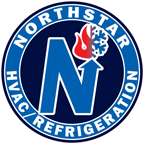The Importance of Compliance with ASHRAE 15 & IIAR Standards
Written by Ed Rice
In the world of commercial and industrial refrigeration, safety and compliance are non-negotiable. As systems grow more complex—and the consequences of a leak or failure grow more severe—adhering to industry standards is essential for protecting your people, property, and operations.
Two of the most critical standards that HVACR professionals, engineers, and facility managers must understand are ASHRAE 15 and the International Institute of Ammonia Refrigeration (IIAR) standards. These codes form the backbone of safe refrigeration system design, installation, and operation, especially when it comes to natural refrigerants like ammonia and CO₂.
In this blog post, we’ll explain what these standards are, why they matter, and how Northstar Refrigeration helps clients stay compliant.
What Is ASHRAE 15?
ASHRAE Standard 15, titled “Safety Standard for Refrigeration Systems”, provides minimum requirements for the safe design, construction, installation, and operation of refrigeration systems.
Key areas it addresses include:
Maximum allowable refrigerant quantities per occupancy type
Equipment location and access requirements
Refrigerant detection systems
Pressure relief devices and emergency shutoffs
Ventilation for machinery rooms
ASHRAE 15 is particularly relevant when working with synthetic refrigerants (like R-410A, R-134a, or new A2L refrigerants), but its principles apply to all systems using refrigerants—including natural refrigerants.
What Are IIAR Standards?
The International Institute of Ammonia Refrigeration (IIAR) develops standards specifically for ammonia and other natural refrigerant systems, which are commonly used in industrial settings such as cold storage, food processing, and ice rinks.
Important IIAR standards include:
IIAR 2: Design Requirements for Closed-Circuit Ammonia Refrigeration Systems
IIAR 4: Installation of Closed-Circuit Ammonia Systems
IIAR 5: Startup and Commissioning of Ammonia Systems
IIAR 6: Inspection, Testing, and Maintenance of Closed-Circuit Ammonia Systems
IIAR 7: Operating Procedures
IIAR 9: Risk Management for Existing Systems
These standards are recognized by OSHA and the EPA, especially for facilities subject to Process Safety Management (PSM) and Risk Management Program (RMP) requirements.
Why Compliance Matters
Safety of Personnel and Property
Non-compliance puts your team, customers, and assets at risk. Refrigerant leaks—especially ammonia—can lead to explosions, toxic exposure, or environmental harm. Following ASHRAE and IIAR standards reduces the risk of accidents through properly designed safety systems.
Regulatory Enforcement and Liability
OSHA and the EPA require facilities using certain refrigerants above specific thresholds to comply with PSM and RMP standards, which incorporate IIAR and ASHRAE codes. Failure to comply may lead to:
Fines and penalties
Work stoppages
Increased insurance costs
Legal liability in the event of an incident
System Longevity and Performance
Properly designed and maintained systems operate more efficiently and last longer. Compliance with ASHRAE 15 and IIAR standards ensures:
Correct sizing and placement of components
Safe pressure relief routing
Optimal airflow and ventilation
Predictable system behavior under normal and emergency conditions
How Northstar Refrigeration Supports Compliance
At Northstar Refrigeration, we take compliance seriously and ensure every project meets or exceeds applicable standards. Our services include:
System Design & Engineering – Built to comply with ASHRAE 15 and IIAR 2, 4, and 5
Startup, Commissioning & Documentation – Following IIAR 5 protocols to validate new systems
Refrigerant Leak Detection and Alarm Systems – Designed per ASHRAE 15
Ventilation and Emergency Shutoffs – Installed to meet safety code requirements
Preventative Maintenance & Testing – In accordance with IIAR 6
Operating Procedures and Risk Reviews – Aligned with IIAR 7 and IIAR 9 standards
Training and Safety Audits – Ensuring your personnel understand what compliance looks like on-site
Whether you're operating an ammonia plant, a cold storage facility, or a CO₂ system, we provide the expertise and documentation you need to remain compliant and safe.
Final Thoughts
Compliance with ASHRAE 15 and IIAR standards isn’t just a legal obligation—it’s a responsibility. It protects your team, your community, and your investment. As natural refrigerants become more common in pursuit of sustainability and low-GWP solutions, these standards are more relevant than ever.
Don’t leave compliance to chance. Partner with Northstar Refrigeration to ensure your systems are safe, efficient, and built to code.
Contact us today at (508) 888-3692 to schedule a compliance audit or consultation.
(508) 888-3692
www.northstarhvacr.com


